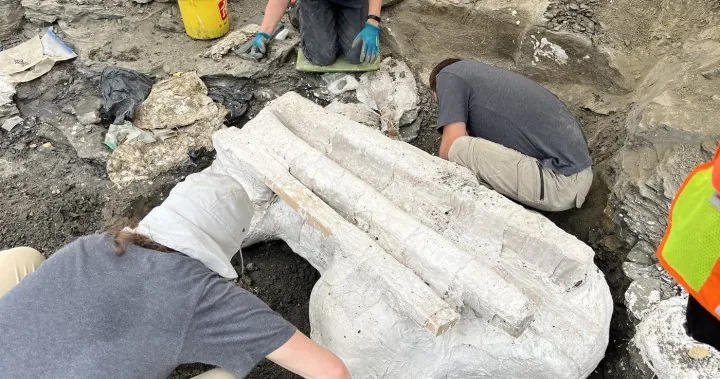
Unearthing a Dinosaur Giant: Paleontologists Discover Enormous Pachyrhinosaurus Skull in Alberta
2024-09-26
Remarkable Discovery
In a remarkable find, paleontologists have unearthed the impressive skull of a Pachyrhinosaurus, a dinosaur that roamed the Alberta badlands over 70 million years ago. This sizeable skull, dubbed "Big Sam," weighs a staggering 272 kilograms and is comparable in size to that of a baby elephant.
Excavation Details
The fossil was excavated near Grande Prairie, located 450 kilometers northwest of Edmonton, from a dense bonebed believed to contain remains of a herd that perished together on the edge of a valley. Notably, this bonebed is one of the richest sources of dinosaur fossils in North America, containing an astonishing 100 to 300 bones per square meter.
Features of the Pachyrhinosaurus
Emily Bamforth, a paleontologist from the Philip J. Currie Dinosaur Museum, described the Pachyrhinosaurus as a plant-eating dinosaur that is akin to a ‘smaller, older cousin’ of the triceratops. While the triceratops is well-known for its prominent nasal horn, the Pachyrhinosaurus features a distinctive bony bump, known as the “boss,” along with additional bumps above the eyes, giving it a unique appearance.
Significance of the Find
"We have unearthed hundreds of juvenile bones in this site, indicating that there were numerous baby dinosaurs alongside some larger adults," Bamforth explained. This discovery underscores the significance of the area, as the species is endemic to the Grande Prairie region, making it a key site for paleontological study.
Historical Context
The journey to this discovery has been extensive; the bonebed was first identified about 50 years ago by a high school teacher. It wasn’t until a decade later that professional paleontologists began to formally study the site. "In the 1970s and 1980s, paleontology was virtually unknown in northern Alberta," noted Bamforth.
Previous Discoveries
Previous discoveries include another adult Pachyrhinosaurus skull, uncovered 16 years ago, which is now displayed at the museum. Both found specimens are hypothesized to have been the elders of their herd, contributing valuable insights into the social structures of these prehistoric creatures.
Challenges in Excavation
The extraction of Big Sam proved to be challenging, as it was intricately embedded within a matrix of approximately 300 other bones. The excavation process was meticulous; plaster was used to encase the skull, and heavy wooden planks provided support before it was gently lifted using a crane for transportation to the museum for further analysis.
Conclusion
"This skull is undoubtedly the largest I’ve ever extracted," Bamforth shared. "The thrill of discovering such a magnificent piece of history is truly unbeatable." This find not only enriches the understanding of Pachyrhinosaurus and its habitat but also highlights Alberta as a treasure trove for dinosaur enthusiasts and researchers alike. As excavations continue, who knows what other prehistoric secrets await discovery beneath Alberta's rugged landscape?









 Brasil (PT)
Brasil (PT)
 Canada (EN)
Canada (EN)
 Chile (ES)
Chile (ES)
 España (ES)
España (ES)
 France (FR)
France (FR)
 Hong Kong (EN)
Hong Kong (EN)
 Italia (IT)
Italia (IT)
 日本 (JA)
日本 (JA)
 Magyarország (HU)
Magyarország (HU)
 Norge (NO)
Norge (NO)
 Polska (PL)
Polska (PL)
 Schweiz (DE)
Schweiz (DE)
 Singapore (EN)
Singapore (EN)
 Sverige (SV)
Sverige (SV)
 Suomi (FI)
Suomi (FI)
 Türkiye (TR)
Türkiye (TR)